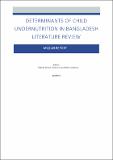MQSUN Determinants of Child Undernutrition in Bangladesh Literature Review

Download
Date
2015-07-14Author
Ahmed, Nabeela
Barnett, Inka
Longhurst, Richard
Metadata
Show full item recordImpact
Abstract
The DFID Programme to Accelerate Improved Nutrition for the Extreme Poor in Bangladesh aims to improve nutrition outcomes for children, mothers and adolescent girls by integrating the delivery of a number of nutrition-specific (or direct) interventions with the livelihood support provided to extremely poor people by three existing programmes in Bangladesh. These three programmes are the Chars Livelihoods Programme (CLP), the Economic Empowerment of the Poorest Programme (EEP) and the Urban Partnership for Poverty Reduction Programme (UPPR).
The purpose of this literature review is to identify, review and summarise existing research evidence on the determinants of undernutrition in children aged two years and below in Bangladesh. The review gathers available evidence on the immediate, underlying and basic determinants of child undernutrition in accordance with the UNICEF conceptual framework of malnutrition (1990).
Child undernutrition is a ‘multi-faceted complex phenomenon’ (Ahmed, T.; Mahfuz, M.; Ireen, S.; Ahmed, A.M.; Rahman, S.; Islam, M.M.; Alam, M.N.; Hossain, M.I.; Rahman, S.M.; Ali, M.M.; Choudhury, F.P. and Cravioto, A. 2012a) and is both an outcome and trigger of health issues. A broad review of the literature concerning child undernutrition in Bangladesh reveals multiple causal factors that are inter-correlated, and thus makes it difficult to ‘empirically determine the key driving factors and underlying pathways’ (Foraita, R.; Klasen, S. and Pigeot, I. 2008). These multiple causal factors differ in terms of nature and proximity to the outcome.
This review takes its reference from the UNICEF Conceptual Framework (1990) and the recently up-dated version in the Lancet (Black et al. 2013) which identifies the basic causes of undernutrition as: household access to resources (such as land, income, technology and income) inadequate social, physical and human capital and the surrounding socio-cultural, political and economic context. These in turn are connected to the underlying causes: household food insecurity, inadequate care and feeding practices, unhealthy household environment and lack of access or inadequate health services. These then feed into the immediate causes, identified as diet and disease/illness. Each category is subdivided into more specific thematic sub-categories, however these sub-divisions should not be considered as discrete as many are cross-cutting and connect with different causal pathways for child undernutrition in the Bangladeshi context. The temporal impact of these factors on nutritional status can be short-term, long-term and intergenerational.
Rights holder
IDS and IFPRICollections
- IDS Research [1671]
